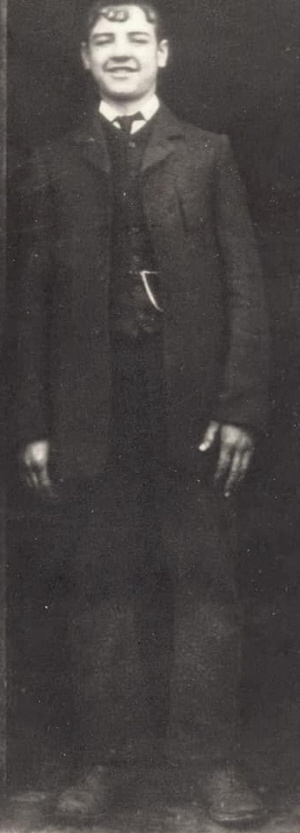
Albert Posliff was born in Castleford on the 17th January 1890, the son of coal miner George Posliff (born 1863, Ossett) and his wife Eliza (nee Brammer), who married on Christmas Eve 1888 at South Ossett Parish Church. Albert was baptised at South Ossett Parish Church on the 28th September 1890 when it is possible that George and Eliza Posliff lived at Radley Street, Ossett Green, where George Posliff had lived with his parents Thomas and Eliza Posliff.
By 1891, George Posliff, Eliza and their son Albert were living in Kassell Street, Castleford and in 1901 they had moved again to live in the pit town of Featherstone. Albert had four siblings by the 1901 census: Annie, aged 10; Ernest, aged 6 years; Percy, aged 4 years and 10 month-old Doris. Another sister, Emma was born in 1906. In 1908, Eliza Posliff and her son Ernest died within a few months of each other.
By 1911, Albert, aged 20 years, was working as a coal miner and lodging at the home of fellow coal miner Cooper Grainger at Halfpenny Lane, Pontefract. In fact, Albert went on to marry Margaret Jane Grainger, the daughter of Cooper Grainger on the 1st January 1912 at St Giles and St Mary’s Church in Pontefract. There were five children born to the couple, but the two youngest: Eliza (b. 1912) and Alice Posliff (b. 1917) both died in early infancy. The other siblings were Lilian (b. 1914), Daisy (b. 1915) and Mabel, who was born in early 1919, after her father’s death.
The Regular 2nd Battalion, K.O.Y.L.I. was stationed in Dublin in August 1914 at the start of WW1 as part of 13th Brigade in 5th Division. On the 16th August 1914 they landed at Le Havre and on the 28th December 1915 they transferred to 97th Brigade in 32nd Division, fighting on the Western Front all the way through WW1.
Private Albert Posliff serving in the 2nd Battalion, K.O.Y.L.I. was part of 97th Brigade, 32 Division, and was probably wounded during the 32 Division action at the Battle of Beaurevoir Line, which took place in late September and early October 1918.
On the 2nd October, the British 46th and 32nd Divisions, supported by the Australian 2nd Division, planned to capture the Beaurevoir Line (the third line of defences of the Hindenburg Line), the village of Beaurevoir and the heights overlooking the Beaurevoir Line. While the attack succeeded in widening the breach in the Beaurevoir Line, it was unable to seize the high ground further on. However, by 2 October, the attack had resulted in a 17 km breach in the Hindenburg Line.
Private Albert Posliff died from wounds on the 27th October 1918, just a couple of weeks before the end of WW1 and is buried at St Sever Cemetery Extension, Rouen. He was awarded the British and Victory Medals, but not the 1914/15 Star and therefore didn’t serve in the Army before 1916.
During the First World War, Commonwealth camps and hospitals were stationed on the southern outskirts of Rouen. A base supply depot and the 3rd Echelon of General Headquarters were also established in the city. Almost all of the hospitals at Rouen remained there for practically the whole of the war. They included eight general, five stationary, one British Red Cross and one labour hospital, and No. 2 Convalescent Depot. A number of the dead from these hospitals were buried in other cemeteries, but the great majority were taken to the city cemetery of St. Sever. In September 1916, it was found necessary to begin an extension, where the last burial took place in April 1920. The cemetery extension contains 8,348 Commonwealth burials of the First World War. Ten of them are unidentified.
References: